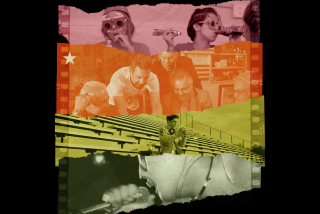ART REVIEW : Carolina, Here He Comes : South of the Border isn’t just a state of mind, it’s a real place, and a perfect jumping-off point for Ortiz’s film odyssey ‘Frontierland/Fronterlandia.’
- Share via
During a listless TV channel check one bleary midnight hour several weeks back, I stumbled upon a scene of glittery Pop glamour and subtle social satire that had me instantly hooked. And wide awake.
On KCET, a tour of a sprawling roadside diner/gift shop/motel/theme park called South of the Border was under way, in a cheery documentary style that had all the cheesy charm of a 1960s promotional film gone rancid.
Having been to South of the Border any number of times as a child, trapped in the back-seat boredom of driving from Massachusetts to Aunt Marion’s house in the central Florida flatlands, I was surprised to discover that the actual border this roadside pit stop was south of was North Carolina’s. Long before becoming a family fun haven out on the interstate, South of the Border started life as a honky-tonk bar, just below the border of a “dry” county apparently filled with beer-thirsty patrons.
“This is worthy of Ruben Ortiz-Torres,” I thought to myself, as deadpan images of plaster cacti and an Eiffel Tower- cum -sombrero flashed by, illuminating the establishment’s bizarre overhaul of its historic equation between wicked pleasures and Mexico. Ortiz is the artist whose cinematic video-montage “How to Read Macho Mouse” (made in collaboration with Aaron Anish) had been among the brightest lights of L.A.’s citywide festival of contemporary art surrounding the huge 1991 exhibition “Mexico: Splendors of Thirty Centuries.”
In that work, as in photographs shown at the Jan Kesner Gallery in 1993 and in numerous group exhibitions, he had been developing a style that might best be thought of as Multicultural Pop. Tired cultural stereotypes of the U.S. and Mexico were dug up and layered into a dense compost heap, creating a startlingly rich and hybridized mix.
And so this program turned out to be. I had arrived midway into a new film by Ortiz and Jesse Lerner, Los Angeles-based artists whose foray “south of the border” to South Carolina was but one episode of a longer, 78-minute project, made with the assistance of the Corp. for Public Broadcasting, the Banff Center for the Arts and the U.S./Mexico Fund for Culture. Their film “Frontierland/Fronterlandia” is an episodic journey through L.A., Mexico City and the San Diego-Tijuana border region--our very own walled Berlin.
The 3,000-mile detour to the Atlantic coast shows how cultural geography is at least as critical to these artists as any physical landscape might be. Ortiz and Lerner build on the border as a metaphor for all kinds of arbitrary, socially determined divisions among people, a metaphor that has been influential for numerous artists since the 1980s. As with “Macho Mouse,” the Disney-ish title of “Frontierland/Fronterlandia” announces a fervent Pop embrace, in which strict divisions between art and the artifacts of popular culture are yet another site for a worthwhile border skirmish.
With a resident historian, a Chicano activist and a storyteller on hand at the start, the film blends history, politics and myth into occasionally lumpy, mostly resonant segments on Chicano rap, Mission-style architecture, the annual Santa Barbara fiesta, the Tijuana assassination of Mexican presidential candidate Luis Donaldo Colosio, a performance artist arrested for wearing a Mexican flag across his chest, a Beatles sound-alike band in a Mexico City nightclub and a gorgeous, dreamlike tour (in black and white) through a huge architectural model of Mexico City, past and present. For good measure, a couple of music videos are thrown in too.
Significantly, “Frontierland/Fronterlandia” is not about erasing social borders or asserting autonomous cultural identities. Instead, Ortiz and Lerner grind them together like tectonic plates, to see what new and surprising forms might erupt. These are artists engaged in the exhilarating business of creating culture, not merely in critiquing it.
* “Frontierland/Fronterlandia” will screen Oct. 20 at UCLA’s Melnitz Auditorium. Information: (310) 206-FILM, after Oct. 10.
More to Read
The biggest entertainment stories
Get our big stories about Hollywood, film, television, music, arts, culture and more right in your inbox as soon as they publish.
You may occasionally receive promotional content from the Los Angeles Times.











